There has been a huge increase in recent years in programmes made by and about LGBTQ+ people, thanks to the hard work of creators and broadcasters to increase positive representation in media. And I couldn’t be happier.
Growing up as a young gay person struggling with my identity, I rarely felt that I saw people like me in the media. Thanks in part to more positive depictions, we’re making real strides in creating a world that reflects everyone in it. With this in mind, I’ve picked out a few iconic moments in LGBTQ+ animated television history from recent years. Let’s dive in!
Fair warning: many of these entries contain late-game spoilers for their respective shows because some media companies have a habit of not allowing explicit queerness on screen until the show is coming to an end.
Avatar: The Legend of Korra – Finale, 2014
![]()
The Avatar franchise takes place in a world where many people can bend the elements to their will, and follows the titular Avatar, the only one who can master all four. The Legend of Korra follows a young and sheltered Avatar navigating an increasingly complicated world. The show tackles big topics, including the impacts of rapid modernisation, inequality, fascism and PTSD. Korra constantly has to prove that there is still a place for the Avatar in the world. She is strong and capable, yet spends much of her life in doubt.
Luckily, Korra has a cast of friends and allies. One of these is Asami Sato, an engineer and business CEO introduced in the first season. After a rocky start (and a rather rubbish love triangle with another Team Avatar member, Mako), Asami and Korra become very close, with Korra confiding in Asami at her lowest point, rather than any of her friends or mentor. Throughout the show, nothing is made concrete about the nature of their relationship. But in the finale, Korra leaves for her next adventure, hand in hand with Asami, the pair looking into each other’s eyes as the show rolls into credits. It may feel subtle by today’s standards, but this moment of heavily implied romantic connection was huge at the time. Comics set after this episode helped clarify and flesh out their relationship, confirming that this final shot of the show was the start of one of Western animation’s first confirmed LGBTQ+ relationships.
This moment of representation went on to influence many other shows, including ones below on this list, and marked a turning point in representation in media largely aimed towards younger viewers. As we say on the internet: Korra walked so others can run.
Adventure Time – Bubbline becomes canon, 2018
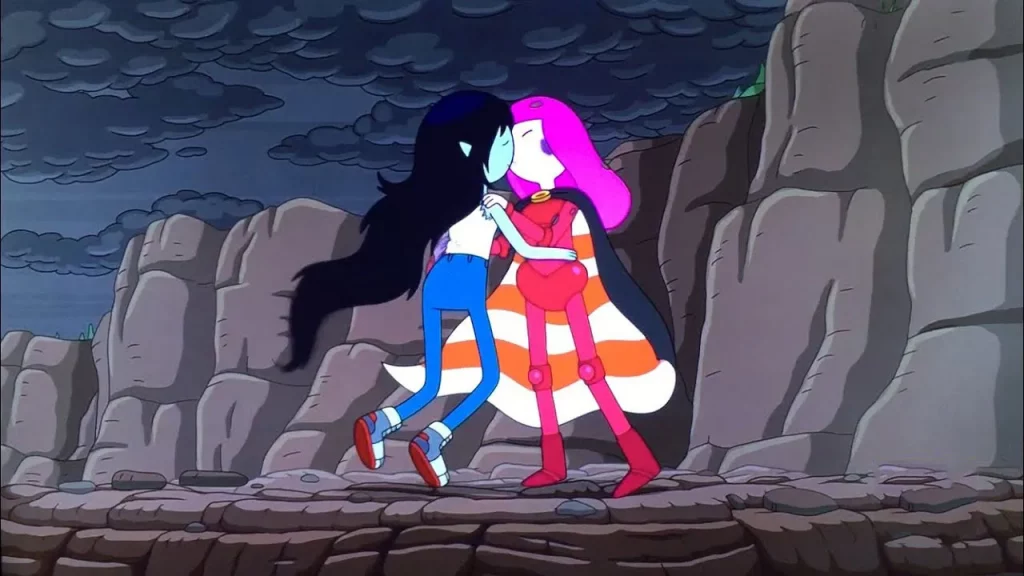
Adventure Time is set in the Land of Ooo—a post-nuclear world with magic, candy people and endless imagination. The show principally follows the surreal adventures of Finn and Jake, but one thing fans picked up from early in the show’s run was the implied past relationship between Princess Bonnie Bubblegum and Marceline the Vampire Queen. What begins as snarky comments and secret feelings develops into a genuine friendship and then, in the finale of the show, an on-screen declaration of feelings and kiss. For many people this unambiguous confirmation signalled the progression of representation during the 2010s.
Their relationship was further fleshed out in a special series set after Adventure Time, that explores their past relationship and their potential future. The special was nominated for a GLAAD Media Award, which honours media that is inclusive and positively depicts LGBTQ+ life.
Steven Universe – Ruby and Sapphire’s Wedding, 2018
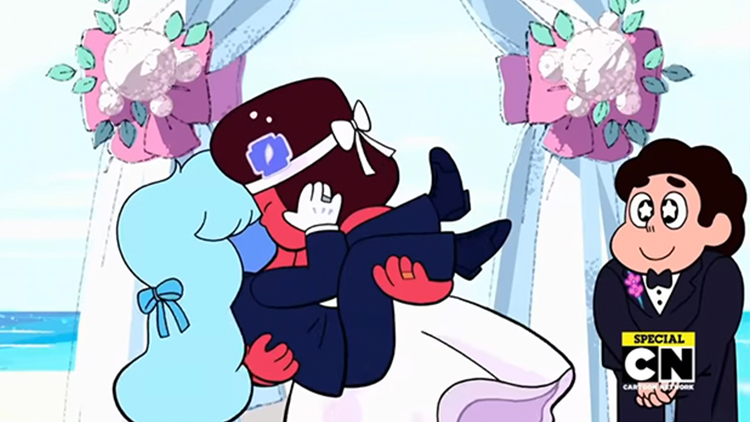
Steven Universe is a cartoon series that follows Steven, a half-human, half Gem (Gems being aliens based around rocks and crystals), boy and his adventures with the Crystal Gems, a group of powerful fighters who protect the earth. The series develops into a sprawling coming-of-age tale of love, growth, forgiveness and family. It has incredible representation, showing identities ranging from lesbian to pansexual and non-binary, and depicts same-sex and polyamorous relationships too.
The core of the show is about relationships and how we truly connect with others. One way this is characterised is through ‘fusion’ where multiple beings can temporarily become one, for all kinds of reasons. It is made clear throughout the show that fusion represents a kind of relationship—not always romantic, but an effort to share an experience with someone else, harmonising and briefly becoming a single being.
Garnet is a romantic fusion of Ruby (a Gem soldier) and Sapphire (a future-seeing noble advisor). Garnet is special because as a fusion she is largely permanent, representing Ruby and Sapphire’s unwillingness to ever be apart. Also, Garnet is the first fusion in the show to be made of two different Gem types. In the Gem world, fusion is seen as a practical thing, making weaker Gems stronger, and something that only Gems of the same type should do. Garnet represents a major deviation from the norm, and she has to fight just to be herself. Garnet is a powerful representation of a queer relationship.
Even though Ruby and Sapphire have been together for 5,000 years before the show even starts, their relationship continues to grow as the show progresses, culminating in Ruby proposing to Sapphire; a way to commit to each other, even when they are not fused. Their wedding is the first lesbian wedding featured in a Western television show largely aimed at children, complete with on-screen kiss (not even their first one). I can’t think of anything more iconic.
Before we move on from Steven Universe, I want to reflect on the brilliance of fusion and its flexibility as a concept. We have characters like Garnet who stay fused as a representation of their love. We have other Gems who fuse occasionally, and Gems who do not fuse at all. None of these are treated as being more ‘correct’ than others, which adds to the show’s great presentation of the many kinds of relationships. In one episode, Steven asks his human father, Greg, if he was ever able to fuse with his Gem mother, Rose. A flashback follows Greg attempting to fuse with Rose, thinking it is the only way to prove their relationship is real. They ultimately aren’t able to fuse, but in the attempt, they share their honest feelings with each other for the first time. Greg recounts to Steven: “No, but it wasn’t as important as talking to each other.” In another episode, Garnet describes her experience of being a fusion as “a conversation”. The show’s message again and again is that relationships are built on communication and honesty, no matter what form they take.
All the Gems are also confirmed by series creator Rebecca Sugar as being ‘non-binary women.’ Sugar, who is bisexual and uses she/her and they/them pronouns, says they loved being able to place her experiences through a non-binary lens in the shows characters. The show has won a couple of Emmys for its representation, and its creators have been widely celebrated for fighting for good queer representation, and at times faced threats of cancellation for it. Some countries even overdubbed Ruby with a male sounding voice to make it seem like Ruby and Sapphire were a heterosexual relationship, showing that we still have a long way to go.
Kipo and the Age of Wonderbeasts – Benson Comes Out, 2020
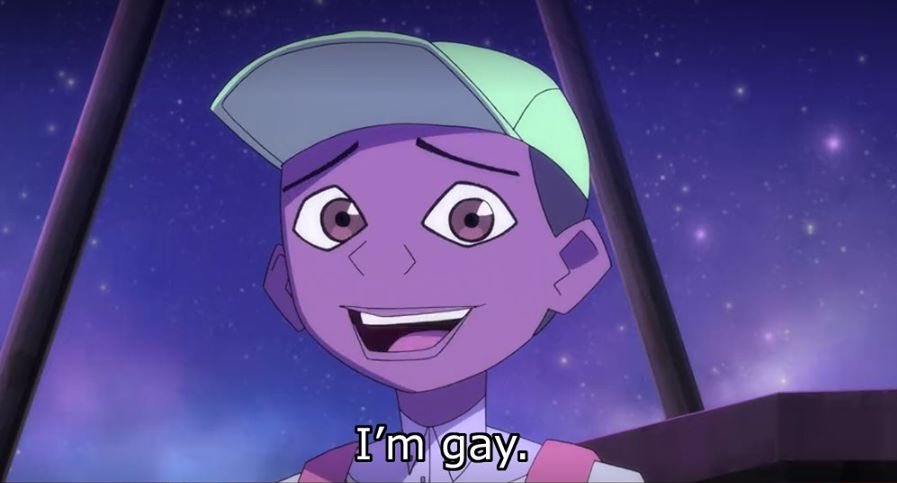
Kipo and the Age of Wonderbeasts is a Netflix series set in a future world where humans largely live underground in burrows hiding from mutated animals (‘Mutes’) who control the surface. Kipo is a teenage girl who finds herself stuck outside her burrow and has to journey across the ruins of civilisation that have been re-taken by nature, and survive potentially deadly encounters with Mutes. As the name implies, the world Kipo finds herself in is wonderful (though dangerous), filled with mafia frogs, rock and roll snakes, and lumberjack cats. She finds new friends as she travels, including a no-nonsense survivalist girl named Wolf, as well as Benson (a human teenager) and Dave (a bug Mute), a dynamic duo of surface scavengers. Together, they explore the ruins of Las Vistas and try to find a way home for Kipo. It’s a super imaginative show and deals a lot with notions of prejudice and xenophobia.
A few episodes in, Kipo and Benson find themselves as a rat-run fairground (‘Ratland’) and on a ferris wheel, a piece of shorthand many films and programmes enjoy using to show two characters falling in love. As the wheel turns, Kipo finds herself considering her feelings for her new friend, and tells Benson she has a crush on him. He responds kindly that he isn’t interested in her in that way because he’s gay. Watching the show as it aired it was so refreshing—hearing someone openly discuss their sexuality like this. Kipo takes it well, understanding that feelings for new people can be confusing and hard to categorise, and their friendship doesn’t suffer for it. It’s just a beautiful moment of people being honest with each other. Benson goes on to get a boyfriend named Troy, and though they don’t get as much screen-time as I would have hoped, they dance, kiss, and even open a restaurant together in the future. Benson is notably the first black lead character in an animated show to openly identify themselves as gay, which helped the show get a nomination for a GLAAD Award.
She-Ra and the Princesses of Power – Adora and Catra Say ‘I Love You’, 2020
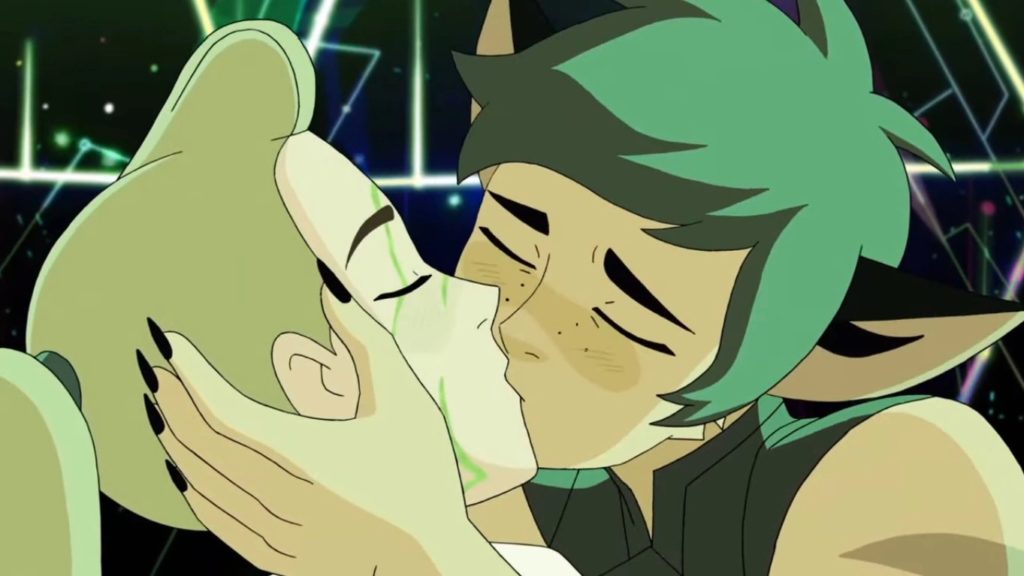
She-Ra and the Princesses of Power is the story of Adora, who discovers—on a planet of princesses and peril—that she is the legendary defender She-Ra, and pledges herself against the armies of the conquering Horde. It has its roots in the He-Man canon, but developed its own fully fledged programme and world beyond the 1980s, not least in its depictions of queerness. The series features wives Spinnerella and Netossa, non-binary character Double Trouble (voiced by non-binary actor and writer Jacob Tobia) and lots more queer representation, with very few characters confirmed as heterosexual.
The iconic moment for this show is in the finale, when Adora and long-standing rival/former friend Catra finally confess their love for each other and kiss. This moment is iconic because of how well it is set up. Adora and Catra go from friends, to enemies, to lovers across the five seasons, and their strong and confusing feelings towards each other drive their interactions and much of the plot of the programme.
Show creator Nate Stevenson has said there needed to be ‘plausible deniability’ of the exact type of feelings Adora and Catra had for each other in the early seasons, but the massive fan support allowed them to tie their relationship into the climax of the show in such a big way. It’s a real ‘love saves the day’ finale, and we love to see it.
Additionally, during the writing of this post Nate Stevenson published this lovely comic on his website about his pronouns, name, and identity journey, which I recommend checking out.
The Owl House – Lumity, 2020 to present
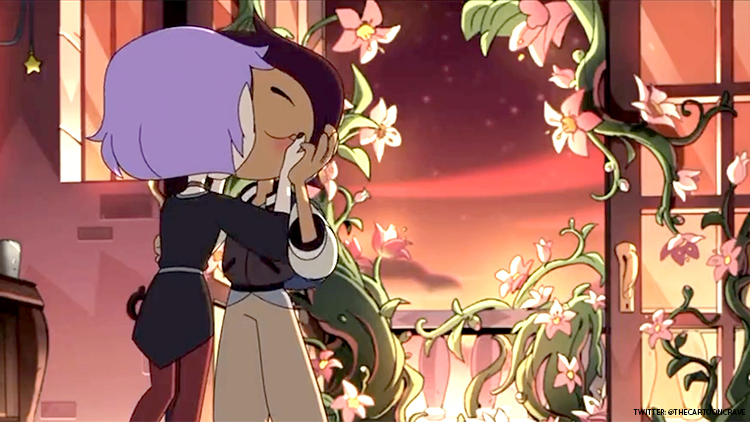
The Owl House is a recent cartoon created by Dana Terrace and broadcast by Disney featuring a queer romance front and centre. In the show, protagonist Luz Noceda (a human who finds herself in a realm of demons and witches) meets and then dates Amity Blight (a witch). This relationship has early placement and prominence within the full text of the show. The relationship is given time to develop and is treated as completely valid. At no point does anyone comment on the sexuality of either Luz or Amity, say it is a phase, or treat the relationship any differently from a heterosexual one. For many of us that is more of an escapist fantasy than an adventure full of magic and witches, and I hope we continue to see positive representation like this.
The series also features a non-binary character, Raine Whispers (voiced by Avi Roque, a transgender non-binary actor), who uses they/them pronouns and has a romantic history with lead character Edith Clawthorne.
Sadly, The Owl House is having its third and final season cut dramatically, causing some controversy as this is such a progressive show.
This selection of moments just scratches the surface of queer representation in television animation—and betrays my love of cartoons! What I want to reflect here is that more than ever it is possible for LGBTQ+ folks to see themselves reflected positively on television. We still have a way to go for true parity, but it encourages me hugely that there have been such massive strides in recent years.